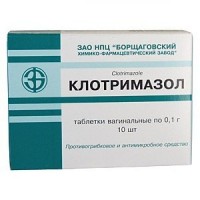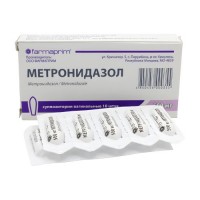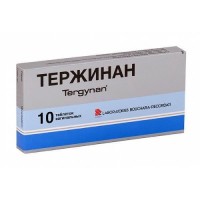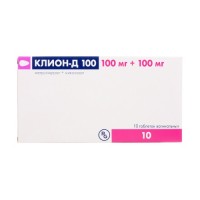Tri-Regol (Levonorgestrel/Ethinyl Estradiol) 21 tablets
- $11.80
Sku:
89a85bbbfa77
Brand:
Gedeon Richter (Hungary)
The instruction for medical use
of Tri-Regol® medicine
the Trade name
of Tri-Regol®
the International unlicensed name
Is not present
the Dosage form
of the Tablet, coated
Sostav
Tri-Regol
I One tablet contains
active agents: ethinylestradiol of 0.03 mg, levonorgestrel of 0.05 mg,
excipients: silicon dioxide colloidal anhydrous, magnesium stearate, talc, starch corn, lactoses monohydrate,
structure of a cover: sucrose, talc, calcium carbonate, titan dioxide (E 171), kopovidon, macrogoal 6000, silicon dioxide colloidal anhydrous, povidone, sodium of a karmelloz, iron (III) oxide red (E172).
Tri-Regol
II One tablet contains
active agents: ethinylestradiol of 0.04 mg, levonorgestrel of 0.075 mg,
excipients: silicon dioxide colloidal anhydrous, magnesium stearate, talc, starch corn, lactoses monohydrate,
structure of a cover: sucrose, talc, calcium carbonate, titan dioxide (E 171), kopovidon, macrogoal 6000, silicon dioxide colloidal anhydrous, povidone, sodium of a karmelloz.
Tri-Regol
III One tablet contains
active agents: ethinylestradiol of 0.03 mg, levonorgestrel of 0.125 mg,
excipients: silicon dioxide colloidal anhydrous, magnesium stearate, talc, starch corn, lactoses monohydrate,
structure of a cover: sucrose, talc, calcium carbonate, titan dioxide (E 171), kopovidon, macrogoal 6000, silicon dioxide colloidal anhydrous, povidone, sodium of a karmelloz, iron (III) oxide yellow (E172).
The description
of the Tablet of round shape, biconvex, with a glossy surface, coated pink color (for the tablets Tri-Regol І).
Tablets of round shape, biconvex, with a glossy surface, coated white color (for the tablets Tri-Regol II).
Tablets of round shape, biconvex, with a glossy surface, coated dark yellow color (for the tablets Tri-Regol III).
Pharmacotherapeutic group
Sex hormones and modulators of a reproductive system. Hormonal contraceptives for system use. Progestogens and estrogen (for calendar reception). Levonorgestrel and ethinylestradiol
the ATX G03AB03 Code
the Pharmacological
Pharmacokinetics Ethinylestradiol properties is quickly and almost completely soaked up from the digestive tract (DT), the maximum concentration in blood serum is reached in 1.5 hours. The Abosolyutny bioavailability - about 60%, almost completely contacts proteins of blood plasma, generally albumine.
Ethinylestradiol is split by presistemny conjugation, passing through an intestines wall (first phase of metabolism), then is exposed to conjugation in a liver (second phase of metabolism). The most important metabolites of the first phase of metabolism 2-OH-ethinylestradiol and 2-metoksi-ethinylestradiol. Both ethinylestradiol, and metabolites of the first phase are emitted in the form of conjugates (sulfates and glucuronides) in bile and are exposed to hepatoenteric circulation. Elimination half-life of 29 hours. About 40% are removed with urine and about 60% with a stake.
Levonorgestrel is quickly soaked up from a GIT (time of full absorption less than 4 hours). Bioavailability of nearly 100%, due to the lack of primary (first pass) metabolism. The most part of levonorgestrel contacts proteins of blood plasma, generally albumine and the globulin, connecting sex hormones (G,CSH).
Elimination half-life of levonorgestrel is characterized by individual variability and makes about 36 hours. Levonorgestrel is removed with urine (40% - 68%) and a stake (16% - 48%) in the form of metabolites (sulphatic and glyukuronidny conjugates).
The pharmacodynamics
of Tri-Regol® - the three-phase combined contraceptive drug, works by braking of products of gonadotrophins, as a result suppresses an ovulation. Increases viscosity of cervical slime that complicates passing of spermatozoa to a cavity of the uterus and also causes changes in endometrium that reduces implantation probability.
Besides contraceptive action, the combined oral contraceptives make positive impact which should be considered when choosing a control method of birth rate.
At the women accepting the combined oral contraceptives, the menstrual cycle becomes more regular, painful periods are less often observed, the intensity of bleeding decreases therefore the risk of an iron deficiency anemia decreases.
There is development of endometrial cancer and ovaries which are also given about risk reduction.
Indications
- oral contraception
the Route of administration and doses
drug Use for the first time
Should be accepted inside on one tablet a day, it is desirable at the same time day, washing down if necessary with a small amount of liquid.
Administration of drug needs to be begun from the first day of a menstrual cycle and to continue within 21 days. After that it is necessary to sustain a seven-day break during which there comes menstrualnopodobny bleeding. The sequence of administration of drug (at first 6 pink, then 5 white and then 10 dark yellow tablets) are specified by figures and an arrow on packing. There is no need for use of an additional method of contraception.
The beginning of reception in 2-7 days also acceptable, but during the first cycle is recommended to use in addition a non-hormonal method of contraception (such as condoms or means destroying spermatozoa) during the first seven days of reception of tablets. Cancellation bleeding usually begins from the 2nd or 3rd day after reception of the last tablet of dark yellow color and can not stop before starting date of reception of the following packing of the drug Tri-Regol®.
The following cycles of administration of drug
the Following 21-day cycle of administration of drug should be begun after a 7-day break. Thus, each cycle begins weeks on the same day.
Transition to administration of drug of Tri-Regol® after intake of other combined drug:
Reception of the first tablet, coated, it is necessary to begin Tri-Regol® next day after you accepted the last active (hormone - containing) a tablet from the blister of the previous contraceptive – but no later than one day after a usual break when using of the previous combined hormonal contraceptive (or after reception of the last tablet of placebo from the previous packing).
Transition from the drug containing only progestogen (the low-dosed oral contraceptive, an injection, an implant or intrauterine contraceptive):
Transition from the low-dosed oral contraceptive to the drug Tri-Regol® can be carried out in any day of a menstrual cycle (from an implant and intrauterine contraceptive next day after their removal, from an injection – in day when following has to be appointed).
In these cases use of an additional method of contraception in the first seven days of reception of tablets is necessary.
After abortion in the 1st trimester:
After abortion in the 1st trimester of pregnancy, reception of an oral contraceptive it is possible to begin immediately. Additional methods of contraception are not required.
After the delivery or abortion in the 2nd trimester:
Oral contraception using the drug Tri-Regol® can be appointed to not feeding woman 21-28 days later after vaginal delivery or abortion in the second trimester of pregnancy. If the beginning of oral contraception using the drug Tri-Regol® occurs later, then use of one of barrier methods as additional contraceptive tool during the first 7 days is necessary.
If sexual intercourse already happened, prior to reception of tablets it is necessary to exclude pregnancy, or reception of tablets should be postponed until the first menstrual bleeding.
The special circumstances demanding use of additional methods of contraception:
The passed pill
At a delay in administration of drug the corresponding tablet needs to be taken at once as soon as it became clear. If the delay makes less than 12 hours, the efficiency of contraceptive drug does not decrease and use of additional methods of contraception is not required. The following pill is taken in usual time.
At the delay exceeding 12 hours, the efficiency of contraception can go down. The woman has to take the last passed pill at once as soon as she remembers, even if it is necessary to take two medicines in one day. Then she should take a pill in usual time. It is necessary to apply additional contraceptives during the next 7 days of reception of tablets. If in the current packing there were less than 7 tablets, it is necessary to begin reception of tablets from the following packing right after reception of the last tablet from the current packing, it means that the pause between packings should not be. In this case, bleeding of cancellation is not expected before the end of the second packing, nevertheless, perhaps show of the smearing discharges and breakthrough bleeding.
If bleeding of cancellation did not occur upon termination of the second packing, it is necessary to exclude pregnancy before resuming of reception of tablets from the following packing.
The recommendation in case of gastrointestinal disorder
in case of development of heavy symptoms of disorder of digestive tract, absorption of active ingredients can be not full and it is necessary to provide additional measures of contraception.
In the vomiting or acute diarrhea which developed within 3 - 4 hours after reception of a tablet, the woman has to follow the advice described for a case with the passed tablets.
A delay of menstrual bleeding
For a delay of menstrual bleeding the reception of the tablets Tri-Regol® from new packing should be begun with tablets of dark yellow color (last phase) next day after the end of the current packing, without pause between them. Duration of a delay of menstrual bleeding depends on quantity of the consumed tablets of dark yellow color from the second packing. During this period the breakthrough bleeding or the smearing discharges can be shown. Regular administration of drug of Tri-Regol® can be resumed after a usual 7-day break.
Side effects
Very often (≥1/10)
- migraine, a headache
- intermenstrual bleedings
Often (≥1/100 to & lt, 1/10)
- nausea, vomiting, pains in a stomach
- a headache, dizziness, a hyperesthesia, a depression, emotional instability
- acne rash, a liquid delay
- tension and morbidity of mammary glands, pains in a breast,
increase in mammary glands, a secret from mammary glands, a dysmenorrhea, an amenorrhea
- change of vaginal secretion, vagina candidiasis
increase or degrowth of a body, change of a libido
Infrequently (≥1/1000 to & lt, 1/100)
- a breast cancer
- decrease or increase in appetite, intestinal gripes, a meteorism, diarrhea
- rash, urticaria, hloazma, a hirsutism, an alopecia
- decrease or increase in sexual desire
- increase in arterial blood pressure
Is rare (≥1/10000 to & lt, 1/1000)
- anaphylactic reactions, urticaria, a Quincke's disease
- thrombosis, a thrombembolia
- an otosclerosis
- intolerance of contact lenses
- increase in level of triglycerides and glucose in blood, decrease in tolerance to glucose, a lipidemia
- cholestatic jaundice
- a knotty erythema, a polymorphic erythema
- a gipofolatemiya
Very seldom (& lt, 1/10000)
- a gepatokletochny carcinoma, adenoma of a liver, a disease of a gall bladder,
- aggravation of a system lupus erythematosus, aggravation of a porphyria, aggravation of a chorea
- an optic neuritis (can lead to partial or full loss of sight), a retina artherothrombosis
- deterioration in varicosity, a myocardial infarction
- pancreatitis, a gemolitiko-uraemic syndrome
- Crohn's disease and nonspecific ulcer colitis
of the Contraindication
the Combined oral contraceptives should not be applied in the presence of any of the states which are listed below. If any of these states develop for the first time against the background of reception, drug has to be immediately cancelled.
- hypersensitivity to any components of drug
venous thrombosis now or in the anamnesis (deep vein thrombosis, a pulmonary embolism) with risk factors or without them
arterial thrombosis now or in the anamnesis (myocardial infarction), or the previous diseases (stenocardia and passing ischemic disturbance)
thrombosis symptoms now or in the anamnesis (passing ischemic disturbance - the PIN, stenocardia)
disorder of cerebral circulation now or in the anamnesis
the heavy degree or existence of multiple factors of risk of venous or arterial thrombosis
cardiovascular disorders (valvulopatiya, arrhythmia episodes)
arterial hypertension in a severe form
diabetes with involvement in a tumor of vessels
disturbance sight of vascular origin
heavy liver diseases, now or in the anamnesis (until indicators of function of a liver not to return to limits of norm
of a tumor of a liver now or in the anamnesis (benign or malignant)
migraine with focal neurologic symptomatology
the malignant tumor caused by sexual steroids (genitals or a mammary gland)
vaginal bleeding of an unknown etiology
pregnancy and the period of a lactation
can lead Medicinal interactions of Interaction between the CPC and other medicines to deterioration in efficiency of contraceptive means and/or to breakthrough bleeding and/or to inefficiency of this method of contraception.
The women accepting any of these drugs are recommended to apply temporarily barrier or other method of contraception in addition to the CPC. At administration of drugs inducing liver enzymes, the barrier method is necessary to use during all course of treatment such drugs and within 28 days after its end.
To the women accepting antibiotics (except for rifampicin and griseofulvin), it is recommended to apply a barrier method for treatment by antibiotics and within 7 days after its end.
If the accompanying medicamentous therapy continues after the termination of tablets from packing of the CPC, the following packing the CPC should be begun without usual break.
Results the drugs inducing microsomal enzymes of a liver in the increased clearance of sex hormones (for example, Phenytoinum, barbiturates, Primidonum, carbamazepine, rifampicin and also, perhaps, okskarbazepin, topiramat, felbamat, griseofulvin and medicines from vegetable raw materials usually on the basis of a St. John's wort of ordinary (Hypericum perforatum)).
HIV protease inhibitors (for example, ritonavir) and nenukleozidny inhibitors of reverse transcriptase (for example, not Virapinum) and also their combinations potentially increase hepatic metabolism.
At co-administration of certain antibiotics (for example, penicillin, tetracyclines) as the accompanying medicines can lead to decrease in concentration of ethinylestradiol in serum.
Troleandomitsin can increase risk of development of an intra hepatic cholestasia in the combined appointment with the CPC.
At short-term use of any active agents inducing enzymes the use of a barrier method since the beginning of intake of the accompanying active agent, during a course of treatment and within four weeks after its termination is recommended. The women undergoing short-term treatment by such antibiotics should apply a barrier method together with contraceptive tablets, i.e. during the period of intake of the accompanying active agent and within seven days after the treatment termination. If these additional measures do not come to an end after the end of packing of the drug Tri-Regol®, the following packing should be begun without interruption. In this case, bleeding of cancellation is not expected before the end of the second packing. If the patient had no cancellation bleeding upon termination of the second packing, she needs to consult with the doctor for an exception of a possibility of pregnancy.
At long-term use of these medicines, use of other methods of contraception is recommended.
It is not recommended to appoint medicines from vegetable raw materials on the basis of a St. John's wort of ordinary (Hypericum perforatum) along with these drugs as it leads to potential to decrease in contraceptive effect of the tablets Tri-Regol®. Messages about breakthrough bleedings and unplanned pregnancy arrived. This fact is proved by induction of the enzymes metabolizing drug by means of Hypericum perforatum. The inducing effect remains, at least, two weeks after the treatment termination by a St. John's wort ordinary.
At joint purpose of the personal computer and cyclosporine raises concentration in plasma of the last.
At the CPC the ability to induce metabolism of a lamotrigin that resulted in subtherapeutic concentration of a lamotrigin in plasma is revealed.
Special instructions
before a course of administration of drug it is necessary to have the general medical and gynecologic examination. First of all it is necessary to measure arterial blood pressure, to perform laboratory examination of urine on presence of glucose, control of function of a liver, inspection of mammary glands and to carry out the cytologic analysis of a vaginal smear, for an exception of diseases and for a pregnancy exception.
The extra care is required during use of drug in the presence of the following diseases: diabetes, arterial hypertension, a varicosity, phlebitis, an otosclerosis, multiple sclerosis, epilepsy, a hysterical chorea, an intermittent porphyria, a latent tetany, bronchial asthma, a benign tumor of a uterus, endometriosis or mastopathy and also are aged more senior than 40 years.
During use of drug it is necessary to have medical examination approximately each 6 months.
In the presence of a liver disease, it is necessary to control its function each 2-3 months.
After the postponed viral hepatitis (after normalization of function of a liver) oral hormonal contraceptives can be applied in 6 months after treatment.
After prolonged use of oral contraceptives, the malignant tumor of a liver which in some cases can lead to life-threatening bleeding can be created seldom benign, in very exceptional cases. At appearance of the profound pain in an upper part of a stomach, increase in a liver or emergence of symptoms of intraabdominal bleeding there can be a suspicion on presence of a tumor of a liver. In case of need it is necessary to interrupt a course of administration of drug.
In a large number of epidemiological researches the frequency of development of ovarian cancer, endometrium, a neck of the uterus and cancer of mammary glands among the women accepting the combined oral contraceptives is studied. Researches showed that the combined oral contraceptives promote reduction of risk of development of ovarian cancer and endometrium.
Some researches found increase in frequency of development of cervical cancer among women who long accepted the combined oral contraceptives. However communication between cervical cancer and use of oral contraceptives is ambiguous.
Among the women accepting the combined oral contraceptives the relative risk of developing a breast cancer increases. However communication between risk of developing of a breast cancer and oral contraception is still not proved.
In the absence of bleeding otnyatiya it is necessary to exclude pregnancy.
At appearance of intermenstrual bleedings the administration of drug should be continued as in most cases these bleedings spontaneously stop. If intermenstrual bleedings do not disappear or repeat, it is necessary to perform medical examination for an exception of damage of genitals.
Among the women accepting the oral contraceptive means containing estrogen the risk of developing thromboembolic diseases (stroke, a myocardial infarction, a subarachnoidal hemorrhage) can increase.
The risk of developing of venous thromboembolic diseases reaches a maximum in the first year of administration of drugs.
Some factors increase the frequency of development of thromboembolic diseases (for example: smoking, obesity, varicosity, cardiovascular diseases, diabetes, migraine). Before a course of reception and in the presence of these factors it is necessary to estimate a ratio advantage/risk of the chosen combined contraceptive.
The risk of appearance of the thromboembolic diseases connected with use of the combined oral contraceptive means increases with age, especially in combination with smoking. Therefore, to women is more senior 35, accepting oral contraceptives, it is recommended to refuse smoking completely.
Presence of thromboembolic diseases in young age and in the family anamnesis plays a role in development of thromboembolic diseases.
Influence on laboratory tests
Reception of the combined oral contraceptives can affect results of some laboratory tests, including indicators of function of a liver, kidneys, a thyroid gland, adrenal glands, level of transport proteins in plasma, indicators of carbohydrate metabolism, parameters of coagulation and a fibrinolysis. Changes usually do not overstep the bounds of normal values.
It is necessary to warn the woman that Tri-Regolâ drugs do not protect from HIV infection (AIDS) and other diseases, sexually transmitted!
Administration of drug immediately should be stopped in the following cases
– in for the first time the arisen or amplified migrenepodobny or unusually severe headache, at acute deterioration in visual acuity, at suspicion of thrombosis or a heart attack,
– at sharp increase in arterial blood pressure, at development of jaundice or hepatitis without jaundice, when developing a generalized itching, in epilepsy or increase of epileptic seizures,
– before the planned operation (in 4 weeks prior to operation), during a long immobilization (for example, after injuries) and in the presence of pregnancy.
Features of influence of medicine on ability to run the vehicle and potentially dangerous mechanisms
the Drug Tri-Regol® does not affect or has insignificant impact on ability to control of vehicles and work with mechanisms, it is necessary to be careful.
Overdose
Symptoms: nausea, vomiting, young girls have an insignificant bleeding.
Treatment: there is no specific antidote, symptomatic treatment, if necessary: gastric lavage, activated carbon.
A form of release and packing
On 21 (Tri-Regol of I – 6 tablets, Tri-Regol of II – 5 tablets, Tri-Regol of III – 10 tablets) a tablet in blister strip packaging from a film of PVH/PVDH and printing aluminum foil varnished.
On 1 or 3 blister strip packagings together with the instruction for medical use in the state and Russian languages put in a pack from cardboard.
To Store storage conditions at a temperature not above 25 °C.
To store out of children's reach!
2 years
not to use a period of storage after expiry date.
Prescription status
According to the prescription
Budapest JSC Gideon Richter Producer 1103, Dyomryoi St., 19-21, Hungary
the Name of the owner of the registration certificate
of JSC Gideon Richter
1103 Budapest, Dyomryoi St., 19-21, Hungary
the Address of the organization accepting in the territory of the Republic of Kazakhstan claims from consumers on quality of products: Representative office of JSC Gideon Richter in RK E-mail: info@richter.kztelefon: 8 (7272)-58-26-22, 8 (7272)-58-26-23
To develop
of Tri-Regol® medicine
the Trade name
of Tri-Regol®
the International unlicensed name
Is not present
the Dosage form
of the Tablet, coated
Sostav
Tri-Regol
I One tablet contains
active agents: ethinylestradiol of 0.03 mg, levonorgestrel of 0.05 mg,
excipients: silicon dioxide colloidal anhydrous, magnesium stearate, talc, starch corn, lactoses monohydrate,
structure of a cover: sucrose, talc, calcium carbonate, titan dioxide (E 171), kopovidon, macrogoal 6000, silicon dioxide colloidal anhydrous, povidone, sodium of a karmelloz, iron (III) oxide red (E172).
Tri-Regol
II One tablet contains
active agents: ethinylestradiol of 0.04 mg, levonorgestrel of 0.075 mg,
excipients: silicon dioxide colloidal anhydrous, magnesium stearate, talc, starch corn, lactoses monohydrate,
structure of a cover: sucrose, talc, calcium carbonate, titan dioxide (E 171), kopovidon, macrogoal 6000, silicon dioxide colloidal anhydrous, povidone, sodium of a karmelloz.
Tri-Regol
III One tablet contains
active agents: ethinylestradiol of 0.03 mg, levonorgestrel of 0.125 mg,
excipients: silicon dioxide colloidal anhydrous, magnesium stearate, talc, starch corn, lactoses monohydrate,
structure of a cover: sucrose, talc, calcium carbonate, titan dioxide (E 171), kopovidon, macrogoal 6000, silicon dioxide colloidal anhydrous, povidone, sodium of a karmelloz, iron (III) oxide yellow (E172).
The description
of the Tablet of round shape, biconvex, with a glossy surface, coated pink color (for the tablets Tri-Regol І).
Tablets of round shape, biconvex, with a glossy surface, coated white color (for the tablets Tri-Regol II).
Tablets of round shape, biconvex, with a glossy surface, coated dark yellow color (for the tablets Tri-Regol III).
Pharmacotherapeutic group
Sex hormones and modulators of a reproductive system. Hormonal contraceptives for system use. Progestogens and estrogen (for calendar reception). Levonorgestrel and ethinylestradiol
the ATX G03AB03 Code
the Pharmacological
Pharmacokinetics Ethinylestradiol properties is quickly and almost completely soaked up from the digestive tract (DT), the maximum concentration in blood serum is reached in 1.5 hours. The Abosolyutny bioavailability - about 60%, almost completely contacts proteins of blood plasma, generally albumine.
Ethinylestradiol is split by presistemny conjugation, passing through an intestines wall (first phase of metabolism), then is exposed to conjugation in a liver (second phase of metabolism). The most important metabolites of the first phase of metabolism 2-OH-ethinylestradiol and 2-metoksi-ethinylestradiol. Both ethinylestradiol, and metabolites of the first phase are emitted in the form of conjugates (sulfates and glucuronides) in bile and are exposed to hepatoenteric circulation. Elimination half-life of 29 hours. About 40% are removed with urine and about 60% with a stake.
Levonorgestrel is quickly soaked up from a GIT (time of full absorption less than 4 hours). Bioavailability of nearly 100%, due to the lack of primary (first pass) metabolism. The most part of levonorgestrel contacts proteins of blood plasma, generally albumine and the globulin, connecting sex hormones (G,CSH).
Elimination half-life of levonorgestrel is characterized by individual variability and makes about 36 hours. Levonorgestrel is removed with urine (40% - 68%) and a stake (16% - 48%) in the form of metabolites (sulphatic and glyukuronidny conjugates).
The pharmacodynamics
of Tri-Regol® - the three-phase combined contraceptive drug, works by braking of products of gonadotrophins, as a result suppresses an ovulation. Increases viscosity of cervical slime that complicates passing of spermatozoa to a cavity of the uterus and also causes changes in endometrium that reduces implantation probability.
Besides contraceptive action, the combined oral contraceptives make positive impact which should be considered when choosing a control method of birth rate.
At the women accepting the combined oral contraceptives, the menstrual cycle becomes more regular, painful periods are less often observed, the intensity of bleeding decreases therefore the risk of an iron deficiency anemia decreases.
There is development of endometrial cancer and ovaries which are also given about risk reduction.
Indications
- oral contraception
the Route of administration and doses
drug Use for the first time
Should be accepted inside on one tablet a day, it is desirable at the same time day, washing down if necessary with a small amount of liquid.
Administration of drug needs to be begun from the first day of a menstrual cycle and to continue within 21 days. After that it is necessary to sustain a seven-day break during which there comes menstrualnopodobny bleeding. The sequence of administration of drug (at first 6 pink, then 5 white and then 10 dark yellow tablets) are specified by figures and an arrow on packing. There is no need for use of an additional method of contraception.
The beginning of reception in 2-7 days also acceptable, but during the first cycle is recommended to use in addition a non-hormonal method of contraception (such as condoms or means destroying spermatozoa) during the first seven days of reception of tablets. Cancellation bleeding usually begins from the 2nd or 3rd day after reception of the last tablet of dark yellow color and can not stop before starting date of reception of the following packing of the drug Tri-Regol®.
The following cycles of administration of drug
the Following 21-day cycle of administration of drug should be begun after a 7-day break. Thus, each cycle begins weeks on the same day.
Transition to administration of drug of Tri-Regol® after intake of other combined drug:
Reception of the first tablet, coated, it is necessary to begin Tri-Regol® next day after you accepted the last active (hormone - containing) a tablet from the blister of the previous contraceptive – but no later than one day after a usual break when using of the previous combined hormonal contraceptive (or after reception of the last tablet of placebo from the previous packing).
Transition from the drug containing only progestogen (the low-dosed oral contraceptive, an injection, an implant or intrauterine contraceptive):
Transition from the low-dosed oral contraceptive to the drug Tri-Regol® can be carried out in any day of a menstrual cycle (from an implant and intrauterine contraceptive next day after their removal, from an injection – in day when following has to be appointed).
In these cases use of an additional method of contraception in the first seven days of reception of tablets is necessary.
After abortion in the 1st trimester:
After abortion in the 1st trimester of pregnancy, reception of an oral contraceptive it is possible to begin immediately. Additional methods of contraception are not required.
After the delivery or abortion in the 2nd trimester:
Oral contraception using the drug Tri-Regol® can be appointed to not feeding woman 21-28 days later after vaginal delivery or abortion in the second trimester of pregnancy. If the beginning of oral contraception using the drug Tri-Regol® occurs later, then use of one of barrier methods as additional contraceptive tool during the first 7 days is necessary.
If sexual intercourse already happened, prior to reception of tablets it is necessary to exclude pregnancy, or reception of tablets should be postponed until the first menstrual bleeding.
The special circumstances demanding use of additional methods of contraception:
The passed pill
At a delay in administration of drug the corresponding tablet needs to be taken at once as soon as it became clear. If the delay makes less than 12 hours, the efficiency of contraceptive drug does not decrease and use of additional methods of contraception is not required. The following pill is taken in usual time.
At the delay exceeding 12 hours, the efficiency of contraception can go down. The woman has to take the last passed pill at once as soon as she remembers, even if it is necessary to take two medicines in one day. Then she should take a pill in usual time. It is necessary to apply additional contraceptives during the next 7 days of reception of tablets. If in the current packing there were less than 7 tablets, it is necessary to begin reception of tablets from the following packing right after reception of the last tablet from the current packing, it means that the pause between packings should not be. In this case, bleeding of cancellation is not expected before the end of the second packing, nevertheless, perhaps show of the smearing discharges and breakthrough bleeding.
If bleeding of cancellation did not occur upon termination of the second packing, it is necessary to exclude pregnancy before resuming of reception of tablets from the following packing.
The recommendation in case of gastrointestinal disorder
in case of development of heavy symptoms of disorder of digestive tract, absorption of active ingredients can be not full and it is necessary to provide additional measures of contraception.
In the vomiting or acute diarrhea which developed within 3 - 4 hours after reception of a tablet, the woman has to follow the advice described for a case with the passed tablets.
A delay of menstrual bleeding
For a delay of menstrual bleeding the reception of the tablets Tri-Regol® from new packing should be begun with tablets of dark yellow color (last phase) next day after the end of the current packing, without pause between them. Duration of a delay of menstrual bleeding depends on quantity of the consumed tablets of dark yellow color from the second packing. During this period the breakthrough bleeding or the smearing discharges can be shown. Regular administration of drug of Tri-Regol® can be resumed after a usual 7-day break.
Side effects
Very often (≥1/10)
- migraine, a headache
- intermenstrual bleedings
Often (≥1/100 to & lt, 1/10)
- nausea, vomiting, pains in a stomach
- a headache, dizziness, a hyperesthesia, a depression, emotional instability
- acne rash, a liquid delay
- tension and morbidity of mammary glands, pains in a breast,
increase in mammary glands, a secret from mammary glands, a dysmenorrhea, an amenorrhea
- change of vaginal secretion, vagina candidiasis
increase or degrowth of a body, change of a libido
Infrequently (≥1/1000 to & lt, 1/100)
- a breast cancer
- decrease or increase in appetite, intestinal gripes, a meteorism, diarrhea
- rash, urticaria, hloazma, a hirsutism, an alopecia
- decrease or increase in sexual desire
- increase in arterial blood pressure
Is rare (≥1/10000 to & lt, 1/1000)
- anaphylactic reactions, urticaria, a Quincke's disease
- thrombosis, a thrombembolia
- an otosclerosis
- intolerance of contact lenses
- increase in level of triglycerides and glucose in blood, decrease in tolerance to glucose, a lipidemia
- cholestatic jaundice
- a knotty erythema, a polymorphic erythema
- a gipofolatemiya
Very seldom (& lt, 1/10000)
- a gepatokletochny carcinoma, adenoma of a liver, a disease of a gall bladder,
- aggravation of a system lupus erythematosus, aggravation of a porphyria, aggravation of a chorea
- an optic neuritis (can lead to partial or full loss of sight), a retina artherothrombosis
- deterioration in varicosity, a myocardial infarction
- pancreatitis, a gemolitiko-uraemic syndrome
- Crohn's disease and nonspecific ulcer colitis
of the Contraindication
the Combined oral contraceptives should not be applied in the presence of any of the states which are listed below. If any of these states develop for the first time against the background of reception, drug has to be immediately cancelled.
- hypersensitivity to any components of drug
venous thrombosis now or in the anamnesis (deep vein thrombosis, a pulmonary embolism) with risk factors or without them
arterial thrombosis now or in the anamnesis (myocardial infarction), or the previous diseases (stenocardia and passing ischemic disturbance)
thrombosis symptoms now or in the anamnesis (passing ischemic disturbance - the PIN, stenocardia)
disorder of cerebral circulation now or in the anamnesis
the heavy degree or existence of multiple factors of risk of venous or arterial thrombosis
cardiovascular disorders (valvulopatiya, arrhythmia episodes)
arterial hypertension in a severe form
diabetes with involvement in a tumor of vessels
disturbance sight of vascular origin
heavy liver diseases, now or in the anamnesis (until indicators of function of a liver not to return to limits of norm
of a tumor of a liver now or in the anamnesis (benign or malignant)
migraine with focal neurologic symptomatology
the malignant tumor caused by sexual steroids (genitals or a mammary gland)
vaginal bleeding of an unknown etiology
pregnancy and the period of a lactation
can lead Medicinal interactions of Interaction between the CPC and other medicines to deterioration in efficiency of contraceptive means and/or to breakthrough bleeding and/or to inefficiency of this method of contraception.
The women accepting any of these drugs are recommended to apply temporarily barrier or other method of contraception in addition to the CPC. At administration of drugs inducing liver enzymes, the barrier method is necessary to use during all course of treatment such drugs and within 28 days after its end.
To the women accepting antibiotics (except for rifampicin and griseofulvin), it is recommended to apply a barrier method for treatment by antibiotics and within 7 days after its end.
If the accompanying medicamentous therapy continues after the termination of tablets from packing of the CPC, the following packing the CPC should be begun without usual break.
Results the drugs inducing microsomal enzymes of a liver in the increased clearance of sex hormones (for example, Phenytoinum, barbiturates, Primidonum, carbamazepine, rifampicin and also, perhaps, okskarbazepin, topiramat, felbamat, griseofulvin and medicines from vegetable raw materials usually on the basis of a St. John's wort of ordinary (Hypericum perforatum)).
HIV protease inhibitors (for example, ritonavir) and nenukleozidny inhibitors of reverse transcriptase (for example, not Virapinum) and also their combinations potentially increase hepatic metabolism.
At co-administration of certain antibiotics (for example, penicillin, tetracyclines) as the accompanying medicines can lead to decrease in concentration of ethinylestradiol in serum.
Troleandomitsin can increase risk of development of an intra hepatic cholestasia in the combined appointment with the CPC.
At short-term use of any active agents inducing enzymes the use of a barrier method since the beginning of intake of the accompanying active agent, during a course of treatment and within four weeks after its termination is recommended. The women undergoing short-term treatment by such antibiotics should apply a barrier method together with contraceptive tablets, i.e. during the period of intake of the accompanying active agent and within seven days after the treatment termination. If these additional measures do not come to an end after the end of packing of the drug Tri-Regol®, the following packing should be begun without interruption. In this case, bleeding of cancellation is not expected before the end of the second packing. If the patient had no cancellation bleeding upon termination of the second packing, she needs to consult with the doctor for an exception of a possibility of pregnancy.
At long-term use of these medicines, use of other methods of contraception is recommended.
It is not recommended to appoint medicines from vegetable raw materials on the basis of a St. John's wort of ordinary (Hypericum perforatum) along with these drugs as it leads to potential to decrease in contraceptive effect of the tablets Tri-Regol®. Messages about breakthrough bleedings and unplanned pregnancy arrived. This fact is proved by induction of the enzymes metabolizing drug by means of Hypericum perforatum. The inducing effect remains, at least, two weeks after the treatment termination by a St. John's wort ordinary.
At joint purpose of the personal computer and cyclosporine raises concentration in plasma of the last.
At the CPC the ability to induce metabolism of a lamotrigin that resulted in subtherapeutic concentration of a lamotrigin in plasma is revealed.
Special instructions
before a course of administration of drug it is necessary to have the general medical and gynecologic examination. First of all it is necessary to measure arterial blood pressure, to perform laboratory examination of urine on presence of glucose, control of function of a liver, inspection of mammary glands and to carry out the cytologic analysis of a vaginal smear, for an exception of diseases and for a pregnancy exception.
The extra care is required during use of drug in the presence of the following diseases: diabetes, arterial hypertension, a varicosity, phlebitis, an otosclerosis, multiple sclerosis, epilepsy, a hysterical chorea, an intermittent porphyria, a latent tetany, bronchial asthma, a benign tumor of a uterus, endometriosis or mastopathy and also are aged more senior than 40 years.
During use of drug it is necessary to have medical examination approximately each 6 months.
In the presence of a liver disease, it is necessary to control its function each 2-3 months.
After the postponed viral hepatitis (after normalization of function of a liver) oral hormonal contraceptives can be applied in 6 months after treatment.
After prolonged use of oral contraceptives, the malignant tumor of a liver which in some cases can lead to life-threatening bleeding can be created seldom benign, in very exceptional cases. At appearance of the profound pain in an upper part of a stomach, increase in a liver or emergence of symptoms of intraabdominal bleeding there can be a suspicion on presence of a tumor of a liver. In case of need it is necessary to interrupt a course of administration of drug.
In a large number of epidemiological researches the frequency of development of ovarian cancer, endometrium, a neck of the uterus and cancer of mammary glands among the women accepting the combined oral contraceptives is studied. Researches showed that the combined oral contraceptives promote reduction of risk of development of ovarian cancer and endometrium.
Some researches found increase in frequency of development of cervical cancer among women who long accepted the combined oral contraceptives. However communication between cervical cancer and use of oral contraceptives is ambiguous.
Among the women accepting the combined oral contraceptives the relative risk of developing a breast cancer increases. However communication between risk of developing of a breast cancer and oral contraception is still not proved.
In the absence of bleeding otnyatiya it is necessary to exclude pregnancy.
At appearance of intermenstrual bleedings the administration of drug should be continued as in most cases these bleedings spontaneously stop. If intermenstrual bleedings do not disappear or repeat, it is necessary to perform medical examination for an exception of damage of genitals.
Among the women accepting the oral contraceptive means containing estrogen the risk of developing thromboembolic diseases (stroke, a myocardial infarction, a subarachnoidal hemorrhage) can increase.
The risk of developing of venous thromboembolic diseases reaches a maximum in the first year of administration of drugs.
Some factors increase the frequency of development of thromboembolic diseases (for example: smoking, obesity, varicosity, cardiovascular diseases, diabetes, migraine). Before a course of reception and in the presence of these factors it is necessary to estimate a ratio advantage/risk of the chosen combined contraceptive.
The risk of appearance of the thromboembolic diseases connected with use of the combined oral contraceptive means increases with age, especially in combination with smoking. Therefore, to women is more senior 35, accepting oral contraceptives, it is recommended to refuse smoking completely.
Presence of thromboembolic diseases in young age and in the family anamnesis plays a role in development of thromboembolic diseases.
Influence on laboratory tests
Reception of the combined oral contraceptives can affect results of some laboratory tests, including indicators of function of a liver, kidneys, a thyroid gland, adrenal glands, level of transport proteins in plasma, indicators of carbohydrate metabolism, parameters of coagulation and a fibrinolysis. Changes usually do not overstep the bounds of normal values.
It is necessary to warn the woman that Tri-Regolâ drugs do not protect from HIV infection (AIDS) and other diseases, sexually transmitted!
Administration of drug immediately should be stopped in the following cases
– in for the first time the arisen or amplified migrenepodobny or unusually severe headache, at acute deterioration in visual acuity, at suspicion of thrombosis or a heart attack,
– at sharp increase in arterial blood pressure, at development of jaundice or hepatitis without jaundice, when developing a generalized itching, in epilepsy or increase of epileptic seizures,
– before the planned operation (in 4 weeks prior to operation), during a long immobilization (for example, after injuries) and in the presence of pregnancy.
Features of influence of medicine on ability to run the vehicle and potentially dangerous mechanisms
the Drug Tri-Regol® does not affect or has insignificant impact on ability to control of vehicles and work with mechanisms, it is necessary to be careful.
Overdose
Symptoms: nausea, vomiting, young girls have an insignificant bleeding.
Treatment: there is no specific antidote, symptomatic treatment, if necessary: gastric lavage, activated carbon.
A form of release and packing
On 21 (Tri-Regol of I – 6 tablets, Tri-Regol of II – 5 tablets, Tri-Regol of III – 10 tablets) a tablet in blister strip packaging from a film of PVH/PVDH and printing aluminum foil varnished.
On 1 or 3 blister strip packagings together with the instruction for medical use in the state and Russian languages put in a pack from cardboard.
To Store storage conditions at a temperature not above 25 °C.
To store out of children's reach!
2 years
not to use a period of storage after expiry date.
Prescription status
According to the prescription
Budapest JSC Gideon Richter Producer 1103, Dyomryoi St., 19-21, Hungary
the Name of the owner of the registration certificate
of JSC Gideon Richter
1103 Budapest, Dyomryoi St., 19-21, Hungary
the Address of the organization accepting in the territory of the Republic of Kazakhstan claims from consumers on quality of products: Representative office of JSC Gideon Richter in RK E-mail: info@richter.kztelefon: 8 (7272)-58-26-22, 8 (7272)-58-26-23
To develop








